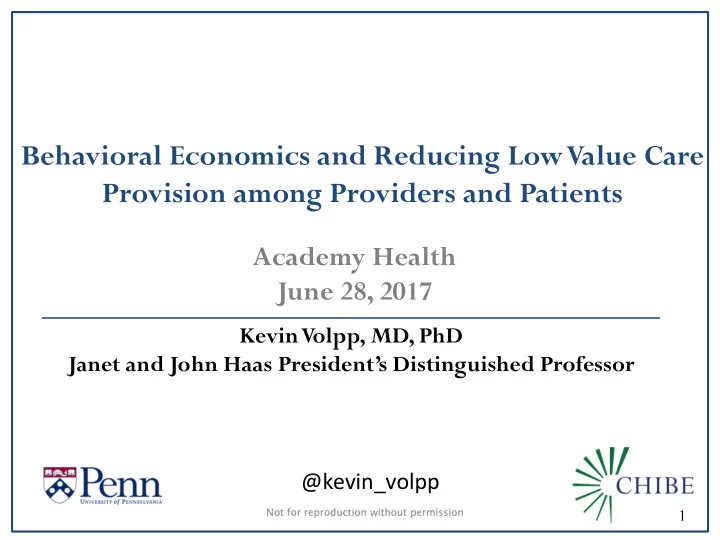

Behavioral Economics and Reducing Low Value Care Provision among Providers and Patients Academy Health June 28, 2017 Kevin Volpp, MD, PhD Janet and John Haas President’s Distinguished Professor @kevin_volpp 1
Agenda • Demand for low value services among patients • Provision of low value services by providers • Thoughts on path forward @kevin_volpp
We can’t assume information alone or economic rationality will prevail Behavioral Economics Standard Economics • People are predictably irrational. • Decisions affected by Information present bias, loss framing, emotions, social context, • People are perfectly inertia rational. • If people know • Incentive delivery and • Size of reward is what what to do, they design and choice matters will do it. environment are critical @kevin_volpp
Providing information has not been all that effective
Price transparency efforts not all that successful “13% to 14% reductions observed “slight relative increase in health for advanced imaging and spending relative to patient common laboratory tests and a populations who were not offered 1% reduction noted these tools” for routine office visits” @kevin_volpp
Behavioral reasons why price transparency may not reduce costs • Framing of choices can make big difference in effectiveness • Consumers assume higher price means higher quality • Services above deductible are seen as ‘free’ • Difficult to engage patients as consumers. . .most don’t use the tools @kevin_volpp
@kevin_volpp
How much is 10% of an ER visit? I don’t know how much I have spent this year and don’t know what 100% of an ER visit costs… @kevin_volpp
Level of understanding of different cost sharing mechanisms is not very high 100% 97% 100% 93% 90% 78% 80% 72% 70% 57% 60% 55% 50% 40% 34% 30% 20% 10% 0% Deductible Copay Coinsurance Max Out-of-Pocket Think Understand Correctly answer question Source: Loewenstein G, Friedman JY, McGill B, Ahmad S, Beshears J, Choi J, Kolstad J, Laibson D, Madrian B, List J, Volpp KG Journal of Health Economics 32(5): 850-862, 2013. @kevin_volpp
Americans have difficulty estimating costs of healthcare Percent of survey respondents correctly estimating cost Source: Loewenstein G, Friedman JY, McGill B, Ahmad S, Beshears J, Choi J, Kolstad J, Laibson D, Madrian B, List J, Volpp KG Journal of Health Economics 32(5): 850-862, 2013. @kevin_volpp
Based on Loewenstein G, Friedman JY, McGill B, Ahmad S, Beshears J, Choi J, Kolstad J, Laibson D, Madrian B, List J, Volpp KG: Journal of Health Economics 32(5): 850-862, June 2013 @kevin_volpp
When the cost is high, patient cost-sharing is high Source: Fendrick AM, et al. Am J Man Care 2001;7:861-867 @kevin_volpp
When the value is high, patient cost-sharing is low Source: Fendrick AM, et al. Am J Man Care 2001;7:861-867 @kevin_volpp
Using behavioral insights to enhance value- based designs Decision Error Example Solution Highlight relative increases in going to more expensive Loss aversion site of care, using lower value care Loss aversion Put rewards at risk if behavior doesn’t change Make relative changes in price tied to value highly salient Mental accounting (don’t bury in premiums) Tell people they would have won had they chosen the Regret aversion higher value alternative Present-biased preferences (myopia) Provide feedback on desired behaviors immediately Status quo bias Modify path of least resistance using well-chosen defaults Loewenstein, G., Brennan, T. and Volpp, K. (2007). Protecting People from Themselves: Using Decision Errors to Help People Improve Their Health. JAMA . 298 (20), 2415-2417; Volpp, Pauly, Loewenstein, Bangsberg, (2009) Pay for Performance for Patients. Health Affairs 28(1): 206-14 @kevin_volpp
Behavior economics applied to physicians -Emanuel, Ezekiel J., et al. "Using behavioral economics to design physician incentives that deliver high-value care." Annals of internal medicine 164.2 (2016): 114-119. -Navathe AS and EJ Emanuel. Physician Peer Comparisons as a Nonfinancial Strategy to Improve the Value of Care. JAMA. 2016. 316 (17). 1759-1760 -Liao JM, LA Fleisher, and AS Navathe. Increasing the Value of Social Comparisons of Physician Performance Using 15 Norms. JAMA. 2016. 316 (11). 1151-1152
New provider payment systems. . . • Promise to create better alignment with health improvement BUT • Many provider payments systems are overly complicated • Incentive systems are difficult to understand • Too many measures being tracked • In many ACOs providers still paid FFS Need to get micro-incentives right and make payment simpler @kevin_volpp
Mahie 2020: Transitioning to a New Primary Care Payment Model 2016 2017+
CHALLENGE – Penn Medicine Clinics Facing Financial Penalties for Low Generic Prescription Utilization • Primary care practices ranked in the bottom quartile compared to peers • Educating physicians did not significantly change prescribing habits • Implemented a change in EHR prescription defaults @kevin_volpp
Rates of generic prescribing heavily influenced by changes in defaults @kevin_volpp
Unnecessary imaging in palliative cancer patients 68% of patients received daily CT scans despite guidelines for no imaging @kevin_volpp
Implementation of evidence-based default at PCAM Before After 68% 30% received daily imaging received daily imaging Team led by Justin Bekelman, M.D., Dept of Radiation Oncology/Medical Ethics and Health Policy, Penn @kevin_volpp
Nudge Units Around the World Penn Medicine Nudge Unit
Summary • Reducing use of low value services requires shifts in both what consumers demand and what providers supply • Ideally these should be aligned • Need to use benefit design/provider payment BUT also should consider systematic use of defaults and other behavioral economic strategies as a way to augment the effectiveness of those incentives @kevin_volpp
Questions? • volpp70@wharton.upenn.edu • www.chibe.upenn.edu @kevin_volpp
Recommend
More recommend